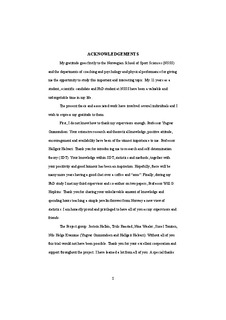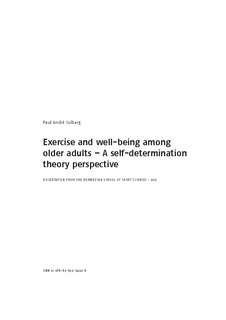| dc.contributor.author | Solberg, Paul André | |
| dc.date.accessioned | 2013-10-01T11:09:25Z | |
| dc.date.available | 2013-10-01T11:09:25Z | |
| dc.date.issued | 2013 | |
| dc.identifier | Seksjon for coaching og psykologi / Department of Coaching and Psychology | |
| dc.identifier.isbn | 978-82-502-0492-8 | |
| dc.identifier.uri | http://hdl.handle.net/11250/171346 | |
| dc.description | Avhandling (doktorgrad) - Norges idrettshøgskole, 2013 | no_NO |
| dc.description.abstract | With an increasing population of older adults there has been
increased interest in the fields of both science and politics in improving older adults’
ability to live a valuable and independent life (WHO, 2002; Nelson et al., 2007).
Being physically active and exercising seems central improving quality of life and
preventing institutionalisation among older adults. However, little is known about
how and for whom exercise influences older adults’ well-being. Few studies have
examined several types of training simultaneously, and hardly any have included a
psychological theory when investigating well-being outcomes among older adults.
Such information is important if we are to create effective interventions in the future,
and to increase activity among older adults.
Objectives: A multidisciplinary study was conducted with the overall aim of
investigating the effects of three types of exercise on muscle strength, physical
function and indices of well-being among older adults. This thesis examines the
effects on well-being. Secondly, there was an aim to identify and test possible
mechanisms for the exercise–well-being effect with variables suggested by selfdetermination
theory (SDT; Deci & Ryan, 1985a; 2000). | no_NO |
| dc.description.abstract | Paper I: Solberg, P. A., Kvamme, N. H., Raastad, T., Ommundsen, Y., Tomten, S. E., Halvari,
H., Loland, N. W., & Hallén, J. (2013). Effects of different types of exercise on
muscle mass, strength, function and well-being in elderly. European Journal of Sport
Science, 13, 112-125. | |
| dc.description.abstract | Paper II: Solberg, P. A., Hopkins, W. G, Ommundsen, Y., & Halvari, H. (2012). Effects of
three training types on vitality among older adults: A self-determination theory
perspective. Psychology of Sport and Exercise, 13, 407-417 | |
| dc.description.abstract | Paper III: Paper III.
Solberg, P. A., Halvari, H., & Ommundsen, Y. (In press). Linking exercise and
causality orientations to change in well-being among older adults: Does change in
motivational variables play a role? Journal of Applied Social Psychology.
doi: 10.1111/jasp.12088 | |
| dc.description.abstract | Paper IV: Solberg, P. A., Halvari, H., Ommundsen, Y., & Hopkins, W. G. (In press). A one-year
follow-up of effects of exercise programs on well-being in older adults. Journal of
Aging and Physical Activity. | |
| dc.language.iso | eng | no_NO |
| dc.subject | trening | no_NO |
| dc.subject | fysisk aktivitet | no_NO |
| dc.subject | eldre | no_NO |
| dc.subject | velvære | no_NO |
| dc.subject | livskvalitet | no_NO |
| dc.subject | mestring | no_NO |
| dc.title | Exercise and well-being among older adults: A self-determination theory perspective | no_NO |
| dc.type | Doctoral thesis | no_NO |
| dc.subject.nsi | VDP::Social science: 200::Social science in sports: 330::Other subjects within physical education: 339 | no_NO |
| dc.subject.nsi | VDP::Medical disciplines: 700::Sports medicine: 850::Exercise techniques: 851 | no_NO |
| dc.subject.nsi | VDP::Social science: 200::Psychology: 260 | no_NO |

